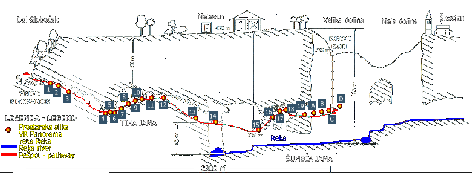 There
are more than 7,000 caves in Slovenia, but an exceptional underground
gorge and a number of vast underground chambers give those in Škocjan a
special place. The Škocjan Caves are composed of a system of eleven
interconnected caves, flatfloored valleys extending over collapsed dolines,
natural bridges and sinkholes. For these reasons, the Caves have been a
UNESCO World Heritage Site since 1986.
There
are more than 7,000 caves in Slovenia, but an exceptional underground
gorge and a number of vast underground chambers give those in Škocjan a
special place. The Škocjan Caves are composed of a system of eleven
interconnected caves, flatfloored valleys extending over collapsed dolines,
natural bridges and sinkholes. For these reasons, the Caves have been a
UNESCO World Heritage Site since 1986.
The
Caves lie in the heart of the Kras region, whence the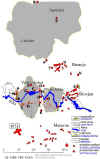 word "karst", used by geologists all over the world, originates.
They are adorned with marvellous multicoloured stalactites, stone curtains
and broad rimstone pools. The Reka river, which gives the caves their
basic features, still cascades through the underground gorge, tumbling
over rock walls and finally coming to rest in small lakes. Visitors stand
amazed and delighted as they gaze into the calm water, which throws back
reflections of the fascinating underground world of the Karst. A tour of
the caves takes an hour and a half with experienced guides.
word "karst", used by geologists all over the world, originates.
They are adorned with marvellous multicoloured stalactites, stone curtains
and broad rimstone pools. The Reka river, which gives the caves their
basic features, still cascades through the underground gorge, tumbling
over rock walls and finally coming to rest in small lakes. Visitors stand
amazed and delighted as they gaze into the calm water, which throws back
reflections of the fascinating underground world of the Karst. A tour of
the caves takes an hour and a half with experienced guides.
 Because
of their extraordinary significance for the world's natural heritage,
the Škocjanske jame were included in UNESCO's World Heritage List in
1986. The Republic of Slovenia pledged to ensure the protection of the Škocjanske
jame area and therefore adopted the Škocjanske jame Regional Park Act.
The Park is managed by the Park Škocjanske jame Public Service Agency,
located in Škocjan 2, Slovenija.
Because
of their extraordinary significance for the world's natural heritage,
the Škocjanske jame were included in UNESCO's World Heritage List in
1986. The Republic of Slovenia pledged to ensure the protection of the Škocjanske
jame area and therefore adopted the Škocjanske jame Regional Park Act.
The Park is managed by the Park Škocjanske jame Public Service Agency,
located in Škocjan 2, Slovenija.
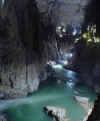 The
Škocjanske jame Regional Park is situated in the south-western part of
Slovenia, in the region called Kras, or Karst. Kras is the area where
researchers first began discovering typical karst formations, karst caves
and other karst features, and is therefore also referred to as the
original or classical Karst. The internationally accepted term used in
karstology for a steep-sided and flat-floored depression -- doline or
dolina -- owes its origins precisely to the dolines in the Škocjan area (Velika
and Mala dolina), where the Reka river disappears underground for the last
time.
The
Škocjanske jame Regional Park is situated in the south-western part of
Slovenia, in the region called Kras, or Karst. Kras is the area where
researchers first began discovering typical karst formations, karst caves
and other karst features, and is therefore also referred to as the
original or classical Karst. The internationally accepted term used in
karstology for a steep-sided and flat-floored depression -- doline or
dolina -- owes its origins precisely to the dolines in the Škocjan area (Velika
and Mala dolina), where the Reka river disappears underground for the last
time.
The
Škocjanske jame Regional Park, which is situated in the Divača
municipality, extends over an area of 413 hectares and encompasses the
area of the caves, the surface above the caves, the system of collapsed
dolines and the Reka river gorge to the bridge in Škoflje. The boundary
of the Park runs along the Kozina-Divača highway on the west, embraces
part of the Divača Karst on the north, and in the south-eastern direction
extends to the feet of the flysch hills of Brkini. The passage of a river
from flysch to limestone is called contact karst, and the Škocjanske jame
caves, which are located in such a passage, are a unique example of this
karst feature.
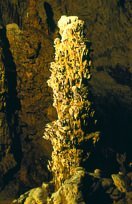 The
Park embraces the characteristic and unique karst landscape combining a
great number of karst features in one place. Together with the system of
caves, collapsed dolines and individual cultural monuments, the Park makes
up a typical karst "architecture". The unusual climatic
conditions in the dolines and at the cave entrances account for the
blended presence of both Alpine and Mediterranean flora. The unique
concentration of plant and animal species cohabiting in such an extremely
small space gives this area a significant value in terms of biotic
diversity. The employees of the Park, in collaboration with local
inhabitants, pay great attention to the protection of the natural
ecosystems and archaeological sites, to the restoration of architectural
heritage, and to sustainable management.
The
Park embraces the characteristic and unique karst landscape combining a
great number of karst features in one place. Together with the system of
caves, collapsed dolines and individual cultural monuments, the Park makes
up a typical karst "architecture". The unusual climatic
conditions in the dolines and at the cave entrances account for the
blended presence of both Alpine and Mediterranean flora. The unique
concentration of plant and animal species cohabiting in such an extremely
small space gives this area a significant value in terms of biotic
diversity. The employees of the Park, in collaboration with local
inhabitants, pay great attention to the protection of the natural
ecosystems and archaeological sites, to the restoration of architectural
heritage, and to sustainable management.
The
Škocjanske jame have an extremely complex system of cave passages in a
total length of 5.8 km. The difference between the lowest and the highest
point in the caves is 209 meters. The caves are the biggest and best known
natural phenomenon within the classical Karst area. With the shifting of
sink holes in the geological past, numerous collapsed dolines have formed
at the contact point where flysch meets limestone under the caverns. With
their depth of 163 meters, Velika dolina and Mala dolina charm every
visitor. The finest view of both dolines with the natural bridge and the
cave that separates them is from an observation point. The caves, with an
immense underground gorge and halls, are the beginning of the Škocjan
underground system. The height of the gorge exceeds 100 meters at several
points. The caves probably have the biggest cave hall in Europe, measuring
12,000 square meters (1.2 hectares) in cross section. The Reka river runs
underground for almost 40 kilometres, to the sources of the Timav in the
Gulf of Trieste.
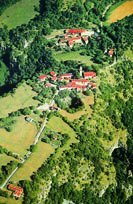 Within the Park's protected area, there are three smaller villages
featuring typical karst architecture: Škocjan, Betanja, and Matavun. The
entire village of Škocjan is especially interesting. It was once a fort,
and with its square and church of Sv. Kancijan (St. Canzian), after which
the caves were named, it is considered a "settlement monument".
There are several archaeological sites in the territory of the Park from
various archaeological periods, including settlements, burial grounds and
cave sites. Because of their special value they are included in the regime
for the protection of cultural heritage. Stone houses with stone wells,
portals, barns for wheat threshing and storage, water mills, ice pits, and
the cemetery with old tombstones form the life and cultural circle of the
local population.
Within the Park's protected area, there are three smaller villages
featuring typical karst architecture: Škocjan, Betanja, and Matavun. The
entire village of Škocjan is especially interesting. It was once a fort,
and with its square and church of Sv. Kancijan (St. Canzian), after which
the caves were named, it is considered a "settlement monument".
There are several archaeological sites in the territory of the Park from
various archaeological periods, including settlements, burial grounds and
cave sites. Because of their special value they are included in the regime
for the protection of cultural heritage. Stone houses with stone wells,
portals, barns for wheat threshing and storage, water mills, ice pits, and
the cemetery with old tombstones form the life and cultural circle of the
local population.
ŠKOCJANSKE
JAME (ŠKOCJAN CAVES) REGIONAL PARK ACT
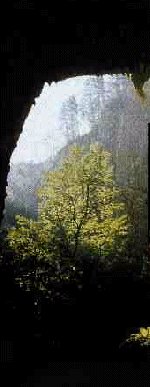 The
Škocjanske jame Regional Park Act was adopted on October 1, 1996, and
published in the Official Gazette of the Republic of Slovenia no. 57/96.
The
Škocjanske jame Regional Park Act was adopted on October 1, 1996, and
published in the Official Gazette of the Republic of Slovenia no. 57/96.
Within the territory of the Škocjanske jame Regional Park it is prohibited:
-
to camp, park and leave motor vehicles or camping trailers outside the areas that are specifically designed for this purpose;
-
to pay unsupervised visits to the caves;
-
to throw away or dispose of waste of all kinds outside the containers that are specifically designed for this purpose;
-
to spill polluted water, oil products or other harmful substances on the surface, into the karst underground or in watercourses;
-
to make a fire or prepare embers in the open or in the vicinity of woods, except in fireplaces that are specifically designed and arranged for this purpose.
-
to use open fire in woods;
-
to transport noxious substances over the territory of the Park;
-
to use motor vehicles of all sorts, except emergency vehicles and agricultural and forestry machinery, outside the public roads:
-
to the artificial entrance to the caves in the Globočak valley;
-
from Betanja towards Ležeški gabrk and on the Dolnje Ležeče-Famlje road;
-
-
to drive, stop, park or organise transportation by motor vehicles or bicycles in the natural environment, except on marked paths;
-
to make changes in vegetation by planting nonindigenous plant species;
-
to disturb, displace, poison, keep in confinement, hunt or kill animals contrary to law or regulations;
-
to pick free-growing plants or parts of plants for commercial purposes;
-
to bring in non-indigenous animal species;
-
to pollute the air beyond permitted levels;
-
to take away sand, gravel or stones from the Reka river's bed or banks;
-
to explore or exploit mineral raw materials.
Within the area of natural monuments the following is also prohibited:
-
to destroy, damage or remove speleothems and other cave inventory;
-
to throw stones and other objects in cave gorges, entrances and precipices;
-
to pollute in any way the walls, ceiling and floor of the caves;
-
to shoot films in the caves;
-
to dig out, pick or carry away individual samples of plant species, except for felling at the cave's entrance for sanitary reasons;
-
to excavate, pick or carry away petrographical, mineralogical or palaeontological samples;
-
to produce noise exceeding 45 Leq (dBA);
-
to set up self-standing poles or antennas;
-
to carry out activities that could endanger the entrances and the vicinity of the caves.
Within the Park's impact area the following activities affecting the environment are prohibited:
-
to alter the existing water regime of the Reka river and the quality of the water, except in cases of protection against floods;
-
other activities affecting the environment which represent a risk or danger to the environment and the harmful impact of which extends into the Park.
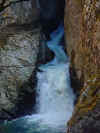 The
Park ranger has a right to fine persons violating the rules that prohibit
the use of motor vehicles of all kinds outside the public roads, the
making of fires in the open, camping, parking and leaving motor vehicles
or camping trailers outside the areas that are specifically designed for
this purpose, and paying unsupervised visits to the caves within the area
of the Škocjanske jame Regional Park. Within the area of the natural
monuments he has the right to impose a fine of SIT 20,000 for polluting
the walls, ceiling and floors of the caves, for throwing stones and other
objects in the cave gorges or entrances and precipices, for making noise
exceeding the permitted levels, and for digging out, picking or carrying
away individual samples of plant or animal species.
The
Park ranger has a right to fine persons violating the rules that prohibit
the use of motor vehicles of all kinds outside the public roads, the
making of fires in the open, camping, parking and leaving motor vehicles
or camping trailers outside the areas that are specifically designed for
this purpose, and paying unsupervised visits to the caves within the area
of the Škocjanske jame Regional Park. Within the area of the natural
monuments he has the right to impose a fine of SIT 20,000 for polluting
the walls, ceiling and floors of the caves, for throwing stones and other
objects in the cave gorges or entrances and precipices, for making noise
exceeding the permitted levels, and for digging out, picking or carrying
away individual samples of plant or animal species.
Dear visitors, we hope you will enjoy the Škocjanske jame Regional Park. Be unobtrusive guests, leaving no traces in nature and taking nothing with you when you depart.
 Because
of their extraordinary significance for the world's natural heritage, in
1986 the Škocjanske jame were included in UNESCOs World Heritage
List. The Republic of Slovenia pledged to ensure the protection of the Škocjanske
jame area and therefore adopted the Škocjanske jame Regional Park
Act. The Park is managed by the Park Škocjanske jame Public Service
Agency, located in Škocjan 2, Slovenia.
Because
of their extraordinary significance for the world's natural heritage, in
1986 the Škocjanske jame were included in UNESCOs World Heritage
List. The Republic of Slovenia pledged to ensure the protection of the Škocjanske
jame area and therefore adopted the Škocjanske jame Regional Park
Act. The Park is managed by the Park Škocjanske jame Public Service
Agency, located in Škocjan 2, Slovenia.
The Škocjanske jame Regional Park is situated in the south-western part of Slovenia, in the region called Kras, or Karst. Kras is the area where researchers first began discovering typical karst formations, karst caves and other karst features, and is therefore also referred to as the original or classical Karst. The internationally accepted term used in karstology for a steep-sided and flat-floored depression -- doline or dolina -- owes its origins precisely to the dolines in the Škocjan area (Velika and Mala dolina), where the Reka river disappears underground for the last time.
The
Škocjanske jame Regional Park, which is situated in the Divača
municipality, extends
over an area of 413 hectares and encompasses the area of the caves, the
surface above the caves, the system of collapsed dolines and the Reka
river gorge to the bridge in Škoflje. The boundary of the Park runs along
the Kozina-Divača highway on the west, embraces part of the Divača Kras
on the north, and in the south-eastern direction extends to the foothills
of the flysch hills of Brkini. The passage of a river from flysch to
limestone is called contact karst, and the Škocjanske jame caves which
are located in such a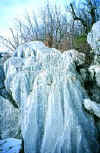 passage, are a unique example of this karst feature.
passage, are a unique example of this karst feature.
The Park embraces the characteristic and unique karst landscape combining a great number of karst features in one place. Together with the system of caves, collapsed dolines and individual cultural monuments, the Park makes up a typical karst "architecture". The unusual climatic conditions in the dolines and at the cave entrances account for the blended presence of both Alpine and Mediterranean flora. The unique concentration of plant and animal species cohabiting in such an extremely small space gives this area a significant value in terms of biotic diversity. The employees of the Park, in collaboration with local inhabitants, pay great attention to the protection of the natural ecosystems and archaeological sites, to the restoration of architectural heritage, and to sustainable management.
 The
Škocjanske jame caves have an extremely complex system of cave
passages in a total length of 5.8 km. The difference between the lowest
and the highest point in the caves is 209 meters. The caves are the
biggest and best known natural phenomenon within the classical Karst area.
With the shifting of sink holes in the geological past, numerous collapsed
dolines have formed at the contact point where flysch meets limestone
under the caverns. With their depth of 163 meters, Velika dolina and Mala
dolina charm every visitor. The finest view of both dolines with the
natural bridge and the cave that separates them is from an observation
point. The caves, with an immense underground gorge and halls, are the
beginning of the Škocjan underground system. The height of the gorge
exceeds 100 meters at several points. The caves probably have the biggest
cave hall in Europe, measuring 12,000 square meters (1.2 hectares) in
cross section. The Reka river runs underground for almost 40 kilometres,
to the sources of the Timav in the Gulf of Trieste.
The
Škocjanske jame caves have an extremely complex system of cave
passages in a total length of 5.8 km. The difference between the lowest
and the highest point in the caves is 209 meters. The caves are the
biggest and best known natural phenomenon within the classical Karst area.
With the shifting of sink holes in the geological past, numerous collapsed
dolines have formed at the contact point where flysch meets limestone
under the caverns. With their depth of 163 meters, Velika dolina and Mala
dolina charm every visitor. The finest view of both dolines with the
natural bridge and the cave that separates them is from an observation
point. The caves, with an immense underground gorge and halls, are the
beginning of the Škocjan underground system. The height of the gorge
exceeds 100 meters at several points. The caves probably have the biggest
cave hall in Europe, measuring 12,000 square meters (1.2 hectares) in
cross section. The Reka river runs underground for almost 40 kilometres,
to the sources of the Timav in the Gulf of Trieste.
Within the Parks protected area, there are three smaller villages featuring typical karst architecture: Škocjan, Betanja, and Matavun. The entire village of Škocjan is especially interesting. It was once a fort, and with its square and church of Sv. Kancijan (St. Canzian), after which the caves were named, it is considered a settlement monument. There are several archaeological sites in the territory of the Park from various archaeological periods, including settlements, burial grounds and cave sites. Because of their special value they are included in the regime for the protection of cultural heritage. Stone houses with stone wells, portals, barns for wheat threshing and storage, water mills, ice pits, and the cemetery with old tombstones form the life and cultural circle of the local population.
Visitors are invited to enjoy the beauties of Kras in our Park as fully as possible and to help preserve local natural and cultural values -- not only for all of us but also for future generations.
The Silent Cave and the Murmuring Cave, which are open for tourists, are the most famous parts of the Škocjan Caves.
The Park is managed by the Park Škocjanske jame Public Service Agency, located in Škocjan 2, Slovenia.
Javni
zavod "Park Škocjanske jame", Slovenija,
Škocjan 2, 6215 Divača
Information:
phone:+386(0)67 632840
fax:+386(0)67 632844
E-mail:
URL: http://www.
